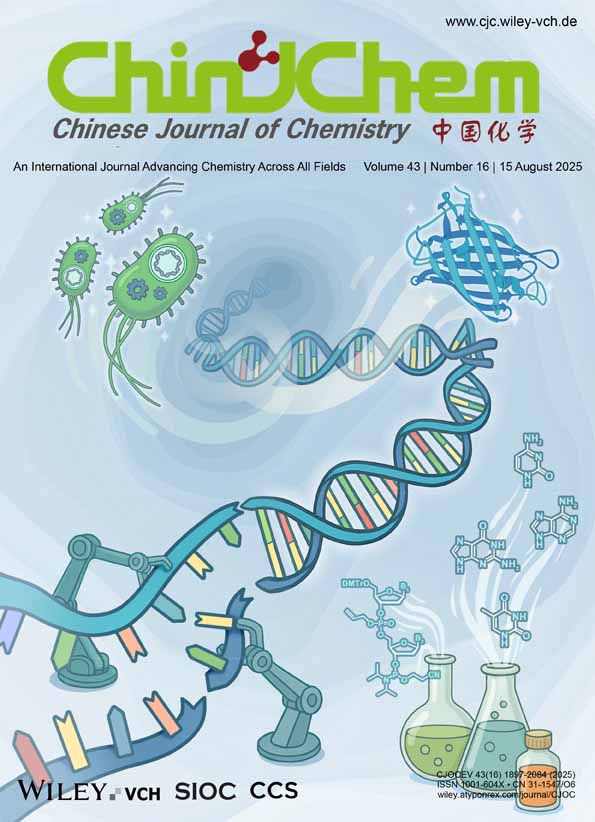Synthesis, Structure and Properties of Benzo[1,2-f:5,4-f′]-diquinoline Derivatives: A Remarkably Strong Intramolecular CH···O Hydrogen Bond
Chun Zhang
Beijing National Laboratory for Molecular Sciences, CAS Key Laboratory of Molecular Recognition and Function, Institute of Chemistry, Chinese Academy of Sciences, Beijing 100190, China
College of Life Science and Technology, Huazhong University of Science and Technology, Wuhan, Hubei 430074, China
Search for more papers by this authorXiaoxia Peng
Beijing National Laboratory for Molecular Sciences, CAS Key Laboratory of Molecular Recognition and Function, Institute of Chemistry, Chinese Academy of Sciences, Beijing 100190, China
Search for more papers by this authorCorresponding Author
Chuanfeng Chen
Beijing National Laboratory for Molecular Sciences, CAS Key Laboratory of Molecular Recognition and Function, Institute of Chemistry, Chinese Academy of Sciences, Beijing 100190, China
Beijing National Laboratory for Molecular Sciences, CAS Key Laboratory of Molecular Recognition and Function, Institute of Chemistry, Chinese Academy of Sciences, Beijing 100190, China, Tel.: 0086-010-62588936; Fax: 0086-010-62554449Search for more papers by this authorChun Zhang
Beijing National Laboratory for Molecular Sciences, CAS Key Laboratory of Molecular Recognition and Function, Institute of Chemistry, Chinese Academy of Sciences, Beijing 100190, China
College of Life Science and Technology, Huazhong University of Science and Technology, Wuhan, Hubei 430074, China
Search for more papers by this authorXiaoxia Peng
Beijing National Laboratory for Molecular Sciences, CAS Key Laboratory of Molecular Recognition and Function, Institute of Chemistry, Chinese Academy of Sciences, Beijing 100190, China
Search for more papers by this authorCorresponding Author
Chuanfeng Chen
Beijing National Laboratory for Molecular Sciences, CAS Key Laboratory of Molecular Recognition and Function, Institute of Chemistry, Chinese Academy of Sciences, Beijing 100190, China
Beijing National Laboratory for Molecular Sciences, CAS Key Laboratory of Molecular Recognition and Function, Institute of Chemistry, Chinese Academy of Sciences, Beijing 100190, China, Tel.: 0086-010-62588936; Fax: 0086-010-62554449Search for more papers by this authorAbstract
A series of benzo[1,2-f:5,4-f′]diquinoline derivatives were synthesized starting from 2,7-diaminoanthracene, and their structures were determined by NMR, MS spectra and X-ray analysis. They showed a remarkably strong intramolecular CH···O hydrogen bond, which resulted in an unexpected downfield chemical shift of the aromatic proton in CDCl3. Moreover, a significant fluorescent change of molecule 1b in the presence of trifluoroacetic acid (TFA) was also observed.
REFERENCES
- 1a Urbano, A.. Angew. Chem., Int. Ed., 2003, 42, 3986.
- 1b Chen, J.-D.; Lu, H.-Y.; Chen, C.-F.. Chem. Eur. J., 2010, 16, 11843 and references therein.
- 2a Xu, Y.; Zhang, Y. X.; Sugiyama, H.; Umano, T.; Osuga, H.; Tanaka, K.. J. Am. Chem. Soc., 2004, 126, 6566.
- 2b Weix, D. J.; Spencer, D. D.; Katz, T. J.. J. Am. Chem. Soc., 2000, 122, 10027.
- 2c Murguly, E.; McDonald, R.; Branda, N. R.. Org. Lett., 2000, 2, 3169.
- 3a Reetz, M. T.; Beuttenmüller, E. W.; Goddard, R.. Tetrahedron Lett., 1997, 38, 3211.
- 3b Dreher, S. D.; Katz, T. J.; Lam, K.-C.; Rheingold, A. L.. J. Org. Chem., 2000, 65, 815.
- 3c Graule, S.; Rudolph, M.; Vanthuyne, N.; Autschbach, J.; Roussel, C.; Crassous, J.; Reau, R.. J. Am. Chem. Soc., 2009, 131, 3181.
- 4 Verbiest, T.; Van Elshocht, S.; Kauranen, M.; Hellemans, L.; Snauwaert, J.; Nuckolls, C.; Katz, T. J.; Persoons, A.. Science, 1998, 282, 913.
- 5 Phillips, K. E. S.; Katz, T. J.; Jockusch, S.; Lovinger, A. J.; Turro, N. J.. J. Am. Chem. Soc., 2001, 123, 11899.
- 6
Verbiest, T.;
Sioncke, S.;
Persoons, A.;
Vyklicky, L.;
Katz, T. J..
Angew. Chem., Int. Ed.,
2002,
41,
3882.
10.1002/1521-3773(20021018)41:20<3882::AID-ANIE3882>3.0.CO;2-C CAS PubMed Web of Science® Google Scholar
- 7a Storch, J.; C̆ermák, J.; Karban, J.; Císařová, I.; Sykora, J.. J. Org. Chem., 2010, 75, 3137.
- 7b Aloui, F.; El Abed, R.; Marinetti, A.; Ben Hassine, B.. Tetrahedron Lett., 2008, 49, 4092.
- 7c Harrowven, D. C.; Guy, I. L.; Nanson, L.. Angew. Chem., Int. Ed., 2006, 45, 2242.
- 7d Nakano, K.; Hidehira, Y.; Takahashi, K.; Hiyama, T.; Nozaki, K.. Angew. Chem., Int. Ed., 2005, 44, 7136.
- 7e Field, J. E.; Hill, T. J.; Venkataraman, D.. J. Org. Chem., 2003, 68, 6071.
- 8a Castellano, R. K.. Curr. Org. Chem., 2004, 8, 845.
- 8b Steiner, T.. Angew. Chem., Int. Ed., 2002, 41, 48.
- 8c Desiraju, G. R.. Acc. Chem. Res., 2002, 35, 565.
- 9a Mizuno, K.; Ochi, T.; Shindo, Y.. J. Chem. Phys., 1998, 109, 9502.
- 9b De Jong, P. H. K.; Wilson, J. E.; Nailson, G. N.; Buckingham, A. D.. Mol. Phys., 1997, 91, 99.
- 9c Donati, A.; Ristori, S.; Bonechi, C.; Panza, L.; Martini, G.; Rossi, C.. J. Am. Chem. Soc., 2002, 124, 8878.
- 10 They can also be called as aza[5]helicene-like molecules. A recent example of helicenes containing anthracene moiety: Sehnal, P.; Stará, I. G.; Šaman, D.; Tichy, M.; Mí šek, J.; Cvac̆ka, J.; Rulíšek, L.; Chocholousova, J.; Vacek, J.; Goryl, G.; Szymonski, M.; Císařová, I.; Stary, I.. Proc. Natl. Acad. Sci. U. S. A., 2009, 106, 13169.
- 11 Sheldrick, G. M., SHELXL-97, Program for the Solution of Crystal Structures, University of Götingen, Germany, 1997.
- 12 Cummings, R. T.; Krafft, G. A.. Tetrahedron Lett., 1988, 29, 65.
- 13a Hu, Z.-Q.; Hu, H.-Y.; Chen, C.-F.. J. Org. Chem., 2006, 71, 1131.
- 13b Hu, H.-Y.; Chen, C.-F.. Tetrahedron Lett., 2006, 47, 175.
- 14 Perry, P. J.; Reszka, A. P.; Wood, A. A.; Read, M. A.; Gowan, S. M.; Dosanjh, H. S.; Trent, J. O.; Jenkins, T. C.; Kelland, L. R.; Neidle, S.. J. Med. Chem., 1998, 41, 4873.




